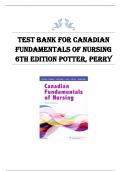Exam (elaborations)
Test Bank for Canadian Fundamentals of Nursing, 6th Edition| Test Bank for Canadian Fundamentals of Nursing 6th Edition by Potter > all chapters 1-48 (questions & answers) A+ guide.
Test Bank for Canadian Fundamentals of Nursing, 6th Edition| Test Bank for Canadian Fundamentals of Nursing 6th Edition by Potter > all chapters 1-48 (questions & answers) A+ guide.
[Show more]



